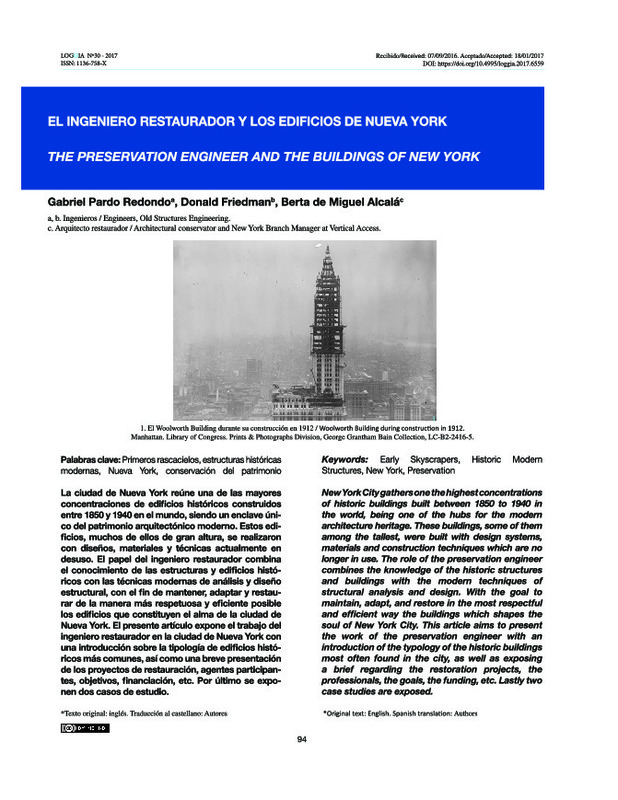JavaScript is disabled for your browser. Some features of this site may not work without it.
Buscar en RiuNet
Listar
Mi cuenta
Estadísticas
Ayuda RiuNet
Admin. UPV
El ingeniero restaurador y los edificios de Nueva York
Mostrar el registro sencillo del ítem
Ficheros en el ítem
| dc.contributor.author | Pardo Redondo, Gabriel
|
es_ES |
| dc.contributor.author | Friedman, Donald
|
es_ES |
| dc.contributor.author | de Miguel Alcalá, Berta
|
es_ES |
| dc.coverage.spatial | east=-74.0059728; north=40.7127753; name=230 Broadway, New York, NY 10007, Estats Units d'Amèrica | |
| dc.date.accessioned | 2018-01-02T10:51:34Z | |
| dc.date.available | 2018-01-02T10:51:34Z | |
| dc.date.issued | 2017-12-20 | |
| dc.identifier.issn | 1136-758X | |
| dc.identifier.uri | http://hdl.handle.net/10251/93725 | |
| dc.description.abstract | [EN] New York City gathers one the highest concentrations of historic buildings built between 1860 to 1940 in the world, being one of the hubs for the modem architecture heritage. These buildings, some of them among the tallest, were built with design systems, materials and construction techniques which are no longer in use. The role of the preservation engineer combines the knowledge of the historic structures and buildings with the modem techniques of structural analysis and design. With the goal to maintain, adapt, and restore in the most respectful and efficient way the buildings which shapes the soul of New York City. This article aims to present the work of the preservation engineer with an introduction of the typology of the historic buildings most often found in the city, as well as exposing a brief regarding the restoration projects, the professionals, the goals, the funding, etc. Lastly two case studies are exposed. | es_ES |
| dc.description.abstract | [ES] La ciudad de Nueva York reúne una de las mayores concentraciones de edificios históricos construidos entre 1850y 1940 en el mundo, siendo un enclave único del pabimonio arquitectónico moderno. Estos edificios. muchos de ellos de gran altura, se realizaron con diseños, materiales y técnicas actualmente en desuso. El papel del ingeniero restaurador combina el conocimiento de las estructuras y edificios históricos con las técnicas modernas de análisis y diseño estructural, con el fin de mantener, adaptar y restaurar de la manera más respetuosa y eficiente posible los edificios que constituyen el alma de la ciudad de Nueva York. El presente artículo expone el trabajo del ingeniero restaurador en la ciudad de Nueva York con una introducción sobre la tipología de edificios históricos más comunes, así como una breve presentación de los proyectos de restauración, agentes participantes, objetivos, financiación, etc. Por último se exponen dos casos de estudio. | es_ES |
| dc.language | Español | es_ES |
| dc.language | Inglés | es_ES |
| dc.publisher | Universitat Politècnica de València | |
| dc.relation.ispartof | Loggia, Arquitectura & Restauración | |
| dc.rights | Reconocimiento - No comercial - Sin obra derivada (by-nc-nd) | es_ES |
| dc.subject | Primeros rascacielos | es_ES |
| dc.subject | Estructuras históricas modernas | es_ES |
| dc.subject | Nueva York | es_ES |
| dc.subject | Conservación del patrimonio | es_ES |
| dc.subject | Early Skyscrapers | es_ES |
| dc.subject | Historic Modern Structures | es_ES |
| dc.subject | New York | es_ES |
| dc.subject | Preservation | es_ES |
| dc.title | El ingeniero restaurador y los edificios de Nueva York | es_ES |
| dc.title.alternative | The preservation engineer and the buildings of New York | es_ES |
| dc.type | Artículo | es_ES |
| dc.date.updated | 2018-01-02T08:42:37Z | |
| dc.identifier.doi | 10.4995/loggia.2017.6559 | |
| dc.rights.accessRights | Abierto | es_ES |
| dc.description.bibliographicCitation | Pardo Redondo, G.; Friedman, D.; De Miguel Alcalá, B. (2017). El ingeniero restaurador y los edificios de Nueva York. Loggia, Arquitectura & Restauración. (30):94-111. https://doi.org/10.4995/loggia.2017.6559 | es_ES |
| dc.description.accrualMethod | SWORD | es_ES |
| dc.relation.publisherversion | https://doi.org/10.4995/loggia.2017.6559 | es_ES |
| dc.description.upvformatpinicio | 94 | es_ES |
| dc.description.upvformatpfin | 111 | es_ES |
| dc.type.version | info:eu-repo/semantics/publishedVersion | es_ES |
| dc.description.issue | 30 | |
| dc.identifier.eissn | 2444-1619 | |
| dc.description.references | AMERICAN INSTITUTE OF STEEL CONSTRUCTION (AISC) 1987. "Guide to Design Criteria for Bolted and Riveted Joints. Second Edition." American Institute of Steel Construction, p. 2. | es_ES |
| dc.description.references | GAYLE, M. & GAYLE, C.1998. Cast-Iron Architecture in America. The Significance of James Bogardus. New York & London: W.W. Norton & Company, p. 130. | es_ES |
| dc.description.references | FRIEDMAN, D. 2010a. Historical Building Construction. Design, Materials & Technology. New York: W.W. Norton & Company, p. 37. | es_ES |
| dc.description.references | FRIEDMAN, D. 2010b. Historical Building Construction. Design, Materials & Technology. New York: W.W. Norton & Company, p. 61. | es_ES |
| dc.description.references | FRIEDMAN, D. & PARDO, G. 2014. ''New York's Tower Building: Structural Analysis of a Proto-Skyscraper". Proceedings of the SAHC 2014- 9th International Conference on Structural Analysis of Historical Constructions. Mexico. | es_ES |
| dc.description.references | FRYER, W. J. (ed.) 1887. "Laws relating to buildings in the city of New York''. The Record and Guide, p.477. | es_ES |
| dc.description.references | INTERNATIONAL BUILDING CODE 2012. ''Additional gravity loads". Article 1103.2 of the 2012 IBC. | es_ES |
| dc.description.references | NYC Emergency management & NYC Department of City Planning 2014. ''NYC's Risk Landscape: A Guide to Hazard Mitigation". New York: Putting Words to Work, p. 137. | es_ES |
| dc.description.references | PAULSON, C., TIDE, R., & MEINHEIT, D. 1996. Modem Techniques for Determining the Capacity of Cast-Iron Columns. ASTM International STP 1258, pp. 186-200. | es_ES |
| dc.description.references | N.A. 1907. ''Notes and Clippings" The American Architect (n1668) volume 92, December 14, 1907. New York: Flat Iron Building, p. 200. | es_ES |








